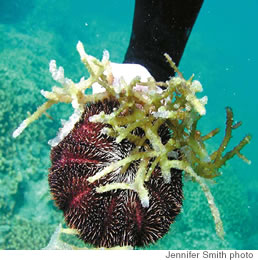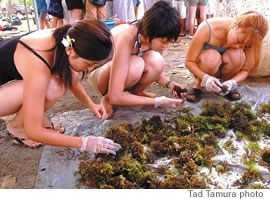Declaring War On Alien Algae
‘Gorilla ogo,’ an alien species of seaweed from the Philippines, is threatening native species — including the good kind used in poke — so dozens of volunteers go on the offensive to root out the bad stuff

This ‘collector urchin’ actually feeds on alien
seaweed species
hopefully. It’s bad.”
Volunteer Cindy Fujioka of DoubleTree Alana Hotel says she liked that nothing was going to waste. “It’s not so much that we’re not adding to the landfill,” she says. “We’re actually doing something really good, taking something that is so negative and turning it into something positive.”
Hawaii has 24 types of alien algae and at least five, including gorilla ogo, are invasive, referring to a rapid growth rate and ability to smother and kill coral and algae. In Kihei on Maui, another type of alien algae “costs the county $20 million a year because their beaches are just piled high with rotting algae,” says UH botany professor Celia Smith. “No one wants to sit on the beach with that stink.”
That scenario doesn’t apply to gorilla ogo, whose worst case scenarios could involve island-wide distribution “with loss of corals in shallow areas,” creating a high-energy coastline and “fewer fish for you to look at in the longer term,” she says.
A leading theory has it that gorilla ogo, or Gracilaria salicornia, first came to Hawaii, at Hilo, aboard 19th or 20th Century ships on ballast rock. More recently, it was brought to Waikiki and Kaneohe Bay in the 1970s by UH researchers to study aquaculture.

UH students Mami Gotoh, Ayaka Nakaji and Lou
Suzuki
The algae took hold “because they were out of their native environment and weren’t subject to the same competition and predation,” says Cynthia Hunter, a UH marine biology assistant professor. “They invented actually new ways of growth here. They don’t form these kinds of mats in their native environments because they’re chewed on. ...
“(This) is something that nobody could predict, which shows that we need to take a precautionary approach to our science.”
The cleanup started four years ago as a project of the Hawaii Marine Algae Group, an association that also manages projects like the super sucker, an underwater machine that with a crew of five can perform algae removal at a rate equal to 200 people. It’s also studying Collector urchins as an algae predator. HIMAG is comprised of The Nature Conservancy of Hawaii, the state Department of Land and Natural Resources Aquatic Resources Division, the University of Hawaii and the Coordinating Group on Alien Pest Species.
In four years, 100 tons of gorilla ogo have been removed from Waikiki. “There’s definitely less algae than there used to be,” but it’s too early to say “we’re the reason for that,” says Signe Opheim, the cleanup coordinator. An upcoming study is expected to shed light.
For diver Nadiera Sukhraj, who’s on the front lines stuffing alien algae into burlap bags, the changes she’s seen over two years are encouraging: less algae and more fish and plate coral. “When we’re down there trying to put the algae in the bags now the fish they swim up to you. You kind of have to swat them away to get the algae in the bags,” she says. “That’s good.”
The next cleanup will be held from 8 a.m. - noon Nov. 18 at the Natatorium. A light lunch will be served. For information, email Opheim at .(JavaScript must be enabled to view this email address).
Page 2 of 2 pages for this story < 1 2
E-mail this story | Print this page | Comments (0) | Archive | RSS
Most Recent Comment(s):








